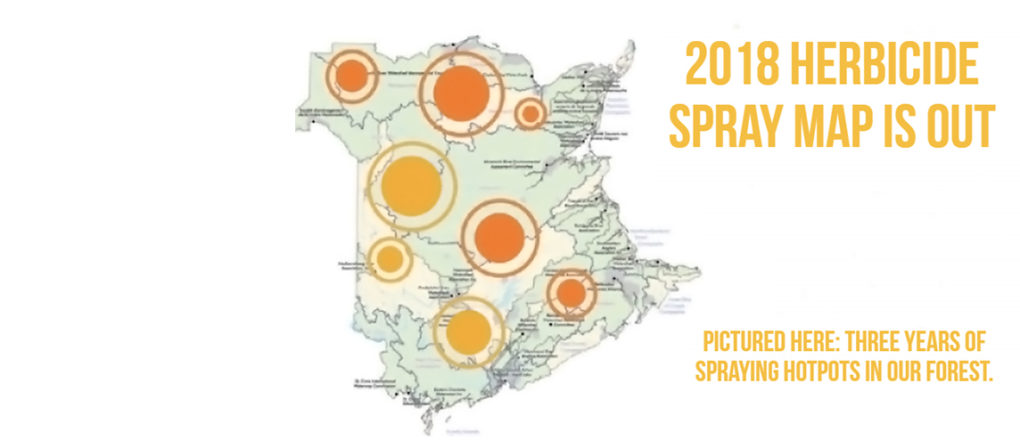[vc_row][vc_column][vc_single_image image=”139434″ img_size=”700 x 400″][/vc_column][/vc_row][vc_row][vc_column][vc_column_text]The map showing where the forests will be sprayed with herbicides during summer 2018 is now available.
Forestry companies spray large swaths of clearcuts with products containing glyphosate — a chemical linked to cancer and a slew of other health problems — beginning in July and continued through August.
The full 2018 spray map is available at forestinfo.ca, a partnership between government and the forestry industry. If you want to know if your community, favourite walking trail, or summer swimming hole is near a spray site you’ll have to zoom in on the map until herbicide spray zones appear.
Our team is poring over the map to help New Brunswickers identify the major spraying hotspots this summer. We started by looking at herbicide spray hotspots near popular N.B. cottage lakes and rivers this summer:[/vc_column_text][/vc_column][/vc_row][vc_row][vc_column][vc_custom_heading text=”Spraying hotspots near New Brunswick lakes” font_container=”tag:h3|text_align:center” google_fonts=”font_family:Alegreya%20Sans%3A100%2C100italic%2C300%2C300italic%2Cregular%2Citalic%2C500%2C500italic%2C700%2C700italic%2C800%2C800italic%2C900%2C900italic|font_style:400%20regular%3A400%3Anormal” css=”.vc_custom_1534349000421{margin-top: -20px !important;}”][/vc_column][/vc_row][vc_row][vc_column][vc_gallery type=”flexslider_slide” interval=”3″ images=”139422,139418,139412,139410,139416,139426,139428,139424,139430,139420,139543″ img_size=”600 x 500″ onclick=”custom_link” custom_links_target=”_blank” custom_links=”#E-8_aHR0cCUzQSUyRiUyRnd3dy5jb25zZXJ2YXRpb25jb3VuY2lsLmNhJTJGZW4lMkYyMDE4LXNwcmF5aW5nLWhvdHNwb3RzLW5lYXItbmV3LWJydW5zd2ljay1sYWtlcyUyRg==” css=”.vc_custom_1534425007574{margin-top: -15px !important;margin-bottom: -25px !important;}”][/vc_column][/vc_row][vc_row][vc_column][vc_custom_heading text=”Click here to see the full images” font_container=”tag:h4|text_align:center|color:%23939659″ google_fonts=”font_family:Alegreya%20Sans%3A100%2C100italic%2C300%2C300italic%2Cregular%2Citalic%2C500%2C500italic%2C700%2C700italic%2C800%2C800italic%2C900%2C900italic|font_style:500%20bold%20regular%3A500%3Anormal” link=”url:http%3A%2F%2Fwww.conservationcouncil.ca%2Fen%2F2018-spraying-hotspots-near-new-brunswick-lakes%2F|||”][vc_empty_space height=”25px”][vc_column_text]How we made these maps: Our team selected popular N.B. rivers and lakes on the 2018 herbicide spray map and zoomed in to reveal the areas being sprayed nearby. For each river and lake, we recorded the spray block I.D., the land manager (forestry company) spraying the block, and the total area in hectares being sprayed, to generate a bird’s eye view of spraying activity. The complete set of data is available at geonb.snb.ca/herbicide/index.html.[/vc_column_text][vc_empty_space height=”25px”][vc_custom_heading text=”Spraying hotspots near New Brunswick rivers” font_container=”tag:h3|text_align:center” google_fonts=”font_family:Alegreya%20Sans%3A100%2C100italic%2C300%2C300italic%2Cregular%2Citalic%2C500%2C500italic%2C700%2C700italic%2C800%2C800italic%2C900%2C900italic|font_style:400%20regular%3A400%3Anormal” css=”.vc_custom_1534519959369{margin-top: -20px !important;}”][vc_gallery type=”flexslider_slide” interval=”3″ images=”139647,139645,139635,139633,139629,139631,139609,139623,139617,139651,139637″ img_size=”550 x 550″ onclick=”custom_link” custom_links_target=”_blank” custom_links=”#E-8_aHR0cCUzQSUyRiUyRnd3dy5jb25zZXJ2YXRpb25jb3VuY2lsLmNhJTJGZW4lMkYyMDE4LXNwcmF5aW5nLWhvdHNwb3RzLW5lYXItbmV3LWJydW5zd2ljay1sYWtlcyUyRg==” css=”.vc_custom_1535116306232{margin-top: -15px !important;margin-bottom: -25px !important;}”][vc_empty_space height=”25px”][vc_empty_space][vc_custom_heading text=”Click here to see the full images” font_container=”tag:h4|text_align:center|color:%23939659″ google_fonts=”font_family:Alegreya%20Sans%3A100%2C100italic%2C300%2C300italic%2Cregular%2Citalic%2C500%2C500italic%2C700%2C700italic%2C800%2C800italic%2C900%2C900italic|font_style:500%20bold%20regular%3A500%3Anormal” link=”url:http%3A%2F%2Fwww.conservationcouncil.ca%2Fen%2F2018-spraying-hotspots-near-new-brunswick-rivers%2F|||”][/vc_column][/vc_row][vc_row][vc_column][vc_custom_heading text=”What’s the problem with spraying herbicides containing glyphosate?” font_container=”tag:h3|text_align:center” google_fonts=”font_family:Alegreya%20Sans%3A100%2C100italic%2C300%2C300italic%2Cregular%2Citalic%2C500%2C500italic%2C700%2C700italic%2C800%2C800italic%2C900%2C900italic|font_style:400%20regular%3A400%3Anormal” css=”.vc_custom_1534340139638{margin-bottom: 20px !important;}”][/vc_column][/vc_row][vc_row][vc_column][vc_single_image image=”7717″ img_size=”700 x 300″][vc_column_text]The forest industry sprays clearcut areas with herbicides to kill hardwoods and vegetation that compete with the spruce, fir and pine companies grow in plantations.
The Conservation Council has long advocated that the province stop the old-fashioned, taxpayer-funded practice of spraying the forest. Quebec banned the spraying of its public forest more than 15 years ago and Nova Scotia stopped using taxpayers’ money to spray its forest. Glyphosate, the main active ingredient in most herbicides used in Crown forest operations in New Brunswick, was listed as a probable carcinogen by the World Health Organization’s cancer research agency, the International Agency for Research on Cancer (IARC), in 2015. Click here to learn more about glyphosate and its health impacts on people and wildlife.
Conservationists, biologists and hunters are worried that spraying vegetation is wiping out the food and habitats of our forest wildlife. The concern among New Brunswickers is so widespread more than 35,000 people have signed a petition to end the old-fashioned practice, organized by Stop Spraying New Brunswick.[/vc_column_text][vc_single_image image=”135444″ img_size=”600″ alignment=”center”][vc_column_text]
Last summer and fall, more than 1,800 New Brunswickers wrote their MLA to call for an end to herbicides in our forest.
Let’s take the herbicides out of the woods and put more people to work in 21st century forestry and silviculture practices that conserve and restore a healthy, resilient and diverse forest![/vc_column_text][vc_single_image image=”3130″ img_size=”700 x 300″][/vc_column][/vc_row][vc_row][vc_column][vc_custom_heading text=”Help us continue our forest conservation efforts.
Donate today!” font_container=”tag:h3|text_align:center|color:%23939659″ google_fonts=”font_family:Alegreya%20Sans%3A100%2C100italic%2C300%2C300italic%2Cregular%2Citalic%2C500%2C500italic%2C700%2C700italic%2C800%2C800italic%2C900%2C900italic|font_style:400%20regular%3A400%3Anormal” link=”url:https%3A%2F%2Fwww.conservationcouncil.ca%2Fen%2Fabout-us%2Fdonate-to-ccnb%2F||target:%20_blank|”][/vc_column][/vc_row]

